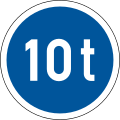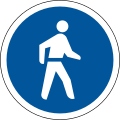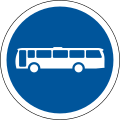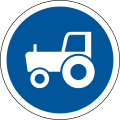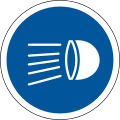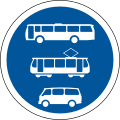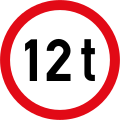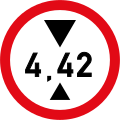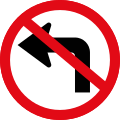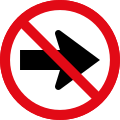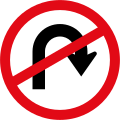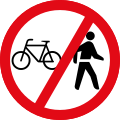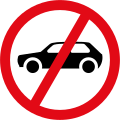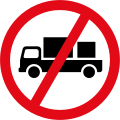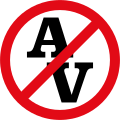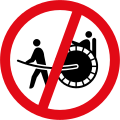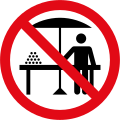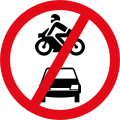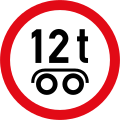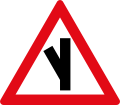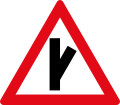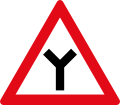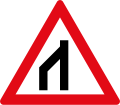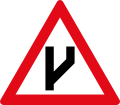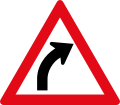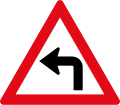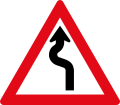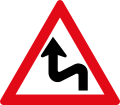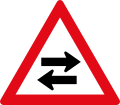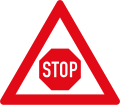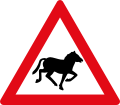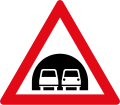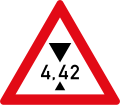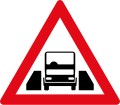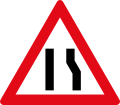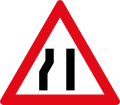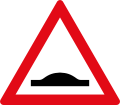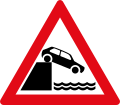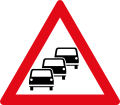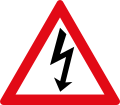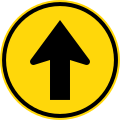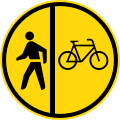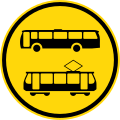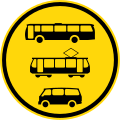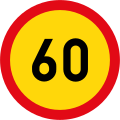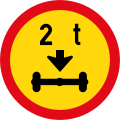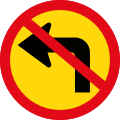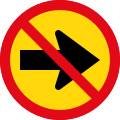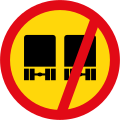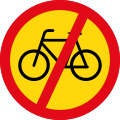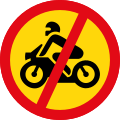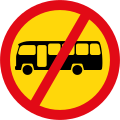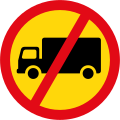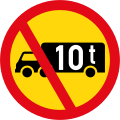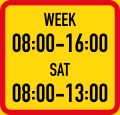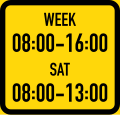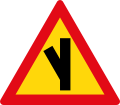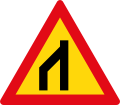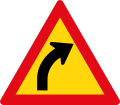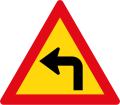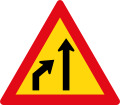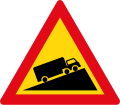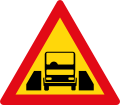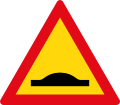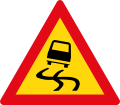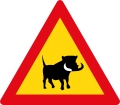Elizabeth Stuart, Queen of Bohemia
Road signs in the Southern African Development Community refer to the harmonised system of road signs in a number of member states of the Southern African Development Community (SADC) – Botswana, Eswatini, Lesotho, Malawi, Mozambique, Namibia, South Africa, Tanzania, Zambia and Zimbabwe. They are regulated in the Southern African Development Community Road Traffic Signs Manual.[1]
Non-SADC member Rwanda[2] has adopted its own road sign system which resemble the SADC design and drives on the right.
Background
Ten SADC member states entered into a Protocol Agreement to develop cooperation in infrastructure and services in June 1995. The intention to harmonise traffic signs among member states was part of this agreement. South Africa offered to take care of the harmonisation process, developing the Road Traffic Signs Manual based on two existing manuals – the Southern Africa Transport and Communications Commission Road Traffic Signs Manual, published in November 1990, and the South African Road Traffic Signs Manual, published in January 1993 – both of which were very similar and based on European traffic signing strategies.[3]
As of 2025, not all SADC member states make use of this system – Comoros, the Democratic Republic of the Congo, Madagascar, Mauritius and Seychelles all make use of their own systems, whereas Angola is transitioning to the SADC design.[4]
The typeface used on SADC road signs is DIN 1451.
National variants
The Road Traffic Signs Manual notes that complete uniformity is unachievable due to differing needs across its member states, such as language and the side of the road on which traffic travels (most of the SADC members drive on the left and speak English as an official language, but Angola and Mozambique speak Portuguese as the official language with the former driving on the right and the latter driving on the left).[3] The manual therefore prescribes 'national variants' to cater for these needs, included in sections at the end of each applicable chapter, indicating the permitted text and mirrored variants.
Permanent road signs
Regulatory signs
Control signs
-
Stop
-
Stop. Two stop
-
Stop. But drivers turning left must give way / yield
-
Stop (3-way)
-
Stop (4-way)
-
Stop / Go manual control sign
-
Give Way / Yield
-
Give Way / Yield to pedestrians
-
Give way / Yield to Equestrians
-
Give way / Yield to pedestrians and equestrians
-
Give Way / Yield at roundabout
-
No entry
-
One-way roadway
-
One-way roadway
-
One-way roadway
-
Pedestrian priority zone
-
Give Way / Yield to oncoming traffic
Command signs
-
Minimum speed limit
-
Vehicles exceeding 10 tonnes GVM only
-
Keep Left
-
Keep Right
-
Turn Left
-
Turn Right
-
Proceed Straight
-
Turn left ahead
-
Turn right ahead
-
Pedestrians only
-
Cyclists only
-
Cyclists and pedestrians only
-
Cyclists and pedestrians only
-
Cyclists and pedestrians only
-
Cyclists and pedestrians only
-
Motorcycles only
-
Motorcars only
-
Taxis only
-
Mini-buses only
-
Midi-buses only
-
Buses only
-
Delivery vehicles only
-
Goods vehicles exceeding 3500 kg only
-
Goods vehicles exceeding 10 tonnes GVM only
-
Construction vehicles only
-
Vehicles transporting dangerous substances only
-
Abnormal vehicles only
-
Rickshaws only
-
Tour buses only
-
Agricultural vehicles only
-
Animal-drawn vehicles only
-
Toll road
-
Switch headlamps on
-
Buses and mini-buses only
-
Buses and midi-buses only
-
Buses, midi-buses and mini-buses only
-
Roundabout
-
Trams only
-
Buses and trams only
-
Buses, trams and mini-buses only
Prohibition signs
-
Speed limit of 5 km/h
-
Speed limit of 10 km/h
-
Speed limit of 20 km/h
-
Speed limit of 30 km/h
-
Speed limit of 40 km/h
-
Speed limit of 50 km/h
-
Speed limit of 60 km/h
-
Speed limit of 70 km/h
-
Speed limit of 75 km/h
-
Speed limit of 80 km/h
-
Speed limit of 90 km/h
-
Speed limit of 100 km/h
-
Speed limit of 120 km/h
-
Vehicles exceeding 12 tonnes GVM prohibited
-
End of weight limit
-
Vehicles exceeding 2 tonnes on a single axle prohibited
-
Vehicles exceeding 4.42 metres in height prohibited
-
Vehicles exceeding 15 metres in length prohibited
-
Excessive noise prohibited / Hooting prohibited
-
Hitch-hiking prohibited
-
Unauthorised vehicles prohibited
-
Left turn prohibited ahead
-
Right turn prohibited ahead
-
Left turn prohibited
-
Right turn prohibited
-
U-turn prohibited
-
Overtaking prohibited
-
Overtaking prohibited for heavy vehicles
-
Parking prohibited
-
Stopping prohibited
-
Pedestrians prohibited
-
Cyclists prohibited
-
Cyclists and pedestrians prohibited
-
Motorcycles prohibited
-
Motorcars prohibited
-
Taxis prohibited
-
Mini-buses prohibited
-
Midi-buses prohibited
-
Buses prohibited
-
Delivery vehicles prohibited
-
Goods vehicles exceeding 3500kg prohibited
-
Goods vehicles exceeding 10 tonnes GVM prohibited
-
Construction vehicles prohibited
-
Vehicles transporting dangerous substances prohibited
-
Abnormal vehicles prohibited
-
Rickshaws prohibited
-
Tour buses prohibited
-
Agricultural vehicles prohibited
-
Animal-drawn vehicles prohibited
-
Horses and riders prohibited
-
Vehicles exceeding 2.1 metres in width prohibited
-
Towed vehicles prohibited
-
Hawkers prohibited
-
Motorcycles and motorcars prohibited
-
Vehicles exceeding 12 tonnes on a tandem axle / bogie axle prohibited
Reservation signs
-
Reserved for buses
-
Reserved lane for buses
-
Start of a reserved lane for buses
-
Reserved lane for bicycles
-
Reserved for motorcycles
-
Reserved for motorcars
-
Reserved for taxis
-
Reserved for mini-buses
-
Reserved for midi-buses
-
Reserved for delivery vehicles
-
Reserved for goods vehicles
-
Reserved for goods vehicles exceeding 10 tonnes GVM
-
Reserved for construction vehicles
-
Reserved for vehicles transporting dangerous substances
-
Reserved for abnormal vehicles
-
Reserved for rickshaws
-
Reserved for tour buses
-
Reserved for high-occupancy vehicles
-
Reserved for ambulances / emergency vehicles
-
Reserved for police vehicles
-
Reserved for vehicles carrying disabled passengers
-
Reserved for diplomatic vehicles
-
Reserved for buses and mini-buses
-
Reserved lane for buses and mini-buses
-
Start of a reserved lane for buses and mini-buses
-
Reserved for buses and midi-buses
-
Reserved lane for buses and midi-buses
-
Start of a reserved lane for buses and midi-buses
-
Reserved for buses, midi-buses and mini-buses
-
Reserved lane for buses, midi-buses and mini-buses
-
Start of a reserved lane for buses, midi-buses and mini-buses
-
Reserved lane for high-occupancy vehicles
-
Start of a reserved lane for high-occupancy vehicles
-
Reserved for trams
-
Reserved lane for trams
-
Start of a reserved lane for trams
-
Reserved for buses and trams
-
Reserved lane for buses and trams
-
Start of a reserved lane for buses and trams
-
Reserved for buses, trams and mini-buses
-
Reserved lane for buses, trams and mini-buses
-
Start of a reserved lane for buses, trams and mini-buses
-
Reserved lane for buses
-
Reserved lane for buses and mini-buses
-
Reserved lane for buses and trams
-
Reserved lane for buses, trams and mini-buses
-
Reserved lane for high-occupancy vehicles
-
Reserved lane for authorised vehicles
-
Reserved lane for authorised vehicles
Parking signs
-
Parking for buses
-
Parking for bicycles
-
Parking
-
Parking with a 60-minute limit
-
Parking for motorcycles
-
Parking for motorcars
-
Parking for taxis
-
Parking for mini-buses
-
Parking for midi-buses
-
Parking for delivery vehicles
-
Parking for goods vehicles
-
Parking for goods vehicles exceeding 10 tonnes GVM
-
Parking for construction vehicles
-
Parking for vehicles transporting dangerous substances
-
Parking for abnormal vehicles
-
Parking for rickshaws
-
Parking for tour buses
-
Parking for high-occupancy vehicles
-
Parking for ambulances / emergency vehicles
-
Parking for police vehicles
-
Parking for vehicles carrying disabled passengers
-
Parking for diplomatic vehicles
-
Parking for buses and mini-buses
-
Parking for buses and midi-buses
-
Parking for buses, midi-buses and mini-buses
Comprehensive signs
-
Dual-carriageway freeway begins
-
Single-carriageway freeway begins
-
Living Street / Woonerf begins
Selective restriction signs
-
Applies during the specified hours
-
Applies during the specified hours
-
Applies during the specified days and hours
-
Applies during the specified days and hours
-
Parking is permitted within the days and hours specified, with a 30-minute limit
-
Parking is permitted within the hours specified, with a 60-minute limit
-
Applies during the day-time hours
-
Applies during the night-time hours
-
Applies to the left
-
Applies to the right
-
Applies to the left and right
-
Pay and display parking
-
Applies to vehicles exceeding 16 tonnes GVM
-
Applies to motorcycles with an engine size up to 125 cc
-
Traffic requiring local access also permitted
-
Applies for 5 kilometres
-
Maximum number of spaces in a parking reservation
-
Applies to buses
-
Applies to cyclists
-
Applies to motorcycles
-
Applies to motorcars
-
Applies to taxis
-
Applies to mini-buses
-
Applies to midi-buses
-
Applies to delivery vehicles
-
Applies to goods vehicles
-
Applies to goods vehicles exceeding 10 tonnes GVM
-
Applies to construction vehicles
-
Applies to vehicles transporting dangerous substances
-
Applies to abnormal vehicles
-
Applies to rickshaws
-
Applies to tour buses
-
Applies to high-occupancy vehicles
-
Applies to ambulances / emergency vehicles
-
Applies to police vehicles
-
Applies to vehicles carrying disabled passengers
-
Applies to diplomatic vehicles
-
Applies to agricultural vehicles
-
Applies to animal-drawn vehicles
-
Applies to towed vehicles
-
Applies to trams
De-restriction signs
-
End of minimum speed limit
-
End of toll route
-
Switch headlamps off
-
End of dual-carriage freeway
-
End of single-carriage freeway
-
End of living street / woonerf
Warning signs
-
Crossroad ahead
-
Crossroad ahead with priority
-
Crossroad ahead without priority
-
T-junction ahead
-
Skewed T-junction ahead
-
Skewed T-junction ahead
-
Side-road junction ahead
-
Side-road junction ahead
-
Staggered side-road junctions ahead
-
Staggered side-road junctions ahead
-
Sharp junction ahead
-
Sharp junction ahead
-
Sharp junction ahead
-
Sharp junction ahead
-
Fork ahead
-
Dual-carriageway ends ahead
-
Dual-carriageway ends ahead
-
Dual-carriageway begins ahead
-
Dual-carriageway begins ahead
-
Roundabout ahead
-
Gentle curve ahead
-
Gentle curve ahead
-
Sharp curve ahead
-
Sharp curve ahead
-
Hairpin curve ahead
-
Hairpin curve ahead
-
Winding road ahead
-
Winding road ahead
-
Series of curves ahead
-
Series of curves ahead
-
Two-way traffic ahead
-
Two-way traffic crossing ahead
-
Right lane ends ahead
-
Left lane ends ahead
-
Concealed driveway ahead
-
Concealed driveway ahead
-
Concealed driveways ahead
-
Traffic signal ahead
-
Stop control ahead
-
Give Way / Yield control ahead
-
Pedestrian crossing ahead
-
Pedestrians ahead
-
Children ahead
-
Cyclists ahead
-
Cattle ahead
-
Horses ahead
-
Sheep ahead
-
Antelopes ahead
-
Gate ahead
-
Motor gate ahead on right
-
Motor gate ahead on left
-
Motor gate ahead
-
Railway crossing ahead
-
Tunnel ahead
-
Height restriction ahead
-
Length restriction ahead
-
Steep descent ahead
-
Steep ascent ahead
-
Slow moving heavy vehicles ahead
-
Unpaved road surface ahead
-
Narrow bridge ahead
-
Single vehicle width passage ahead
-
Roadway narrows from both sides ahead
-
Roadway narrows from the right side ahead
-
Roadway narrows from the left side ahead
-
Uneven road surface ahead
-
Speed hump ahead
-
Slippery road ahead
-
Falling rocks ahead
-
Falling rocks ahead
-
Warning
-
"Danger" flashing light sign
-
Unprotected jetty edge or river bank ahead
-
Crosswinds ahead
-
Drift / Ford ahead
-
Low flying aircraft ahead
-
Agricultural vehicles ahead
-
Reduced visibility ahead
-
Traffic congestion ahead
-
Horse riders ahead
-
Elephants ahead
-
Warthogs ahead
-
Hippos ahead
-
Width restriction ahead
-
Danger of electrical shock
-
Trams ahead
-
Paved road surface ahead
-
Moveable bridge ahead
-
Railway crossing
-
Railway crossing with 2 or more tracks
-
Sharp curve marker
-
Sharp curve marker
-
Sharp curve marker
-
Sharp curve marker
-
T-junction marker
-
Dead end or road closure marker
-
Gore marker
-
Gore marker
Information signs
-
Dead end
-
Dead end
-
Dead end
-
Right-of-way
-
Co-ordinated traffic signals at indicated speed
-
Multi-phase traffic signals
-
Bus stop ahead
-
Bus stop
-
Bus stop for all buses
-
Bus stop for authorised buses with line number
-
Bus stop for authorised buses with line numbers
-
Mini-bus stop
-
Mini-bus stop
-
Mini-bus stop for authorised mini-buses with line number
-
Mini-bus stop for authorised mini-buses with line numbers
-
Right-of-way over oncoming vehicles
-
Information centre
-
Park and Ride
-
Park and Ride
-
Modal transfer point
-
Modal transfer point
-
Modal transfer point
-
Pedestrian crossing
-
Pedestrian crossing (old)
Combo signs
-
Speed limit of 120 km/h during the day
-
Speed limit of 100 km/h during the night
Temporary road signs
Regulatory signs
Command signs
Prohibition signs
Reservation signs
Parking signs
Comprehensive signs
Selective restriction signs
De-restriction signs
Warning signs
Information signs
See also
References
- ^ Transport and Traffic Technology Africa (May 2012). Southern African Development Community Road Traffic Signs Manual (3rd ed.). Department of Transport (South Africa).
- ^ Road Transport Development Agency (December 2014). Road Geometric Design Manual. Retrieved 15 June 2025.
- ^ a b "Chapter 1 – General Principles". Southern African Development Community Road Traffic Signs Manual (PDF). Vol. 1 (3rd ed.). May 2012. Preface. Retrieved 15 June 2025.
- ^ "Decreto Presidencial n.º 209/17 de 25 de setembro". Lex.AO (in Portuguese). Retrieved 14 June 2025.
External links
- Southern African Development Community Road Traffic Signs Manual on the South African Road Traffic Safety Management Association website

 Read
Read
 AUTHORPÆDIA is hosted by Authorpædia Foundation, Inc. a U.S. non-profit organization.
AUTHORPÆDIA is hosted by Authorpædia Foundation, Inc. a U.S. non-profit organization.


















